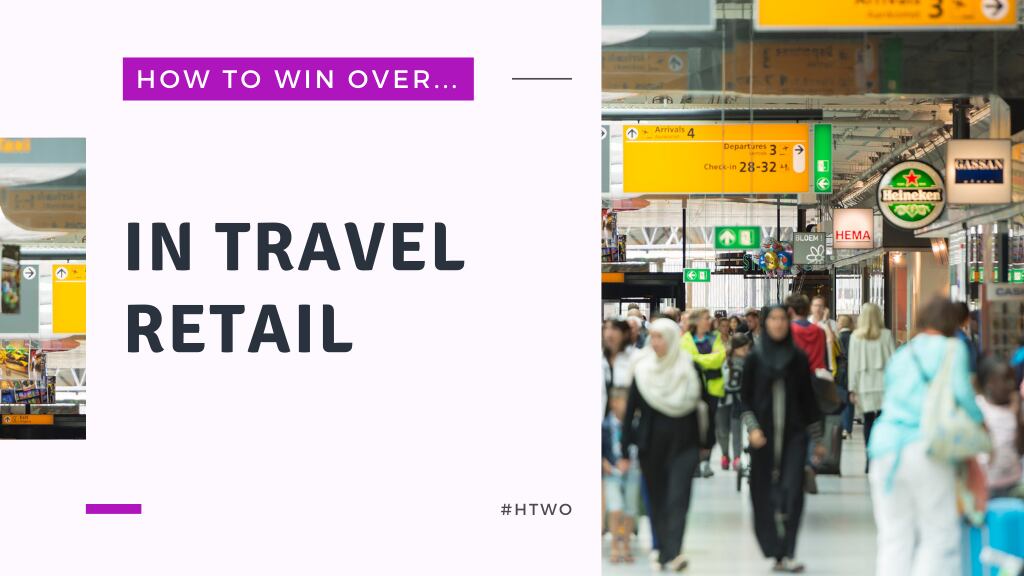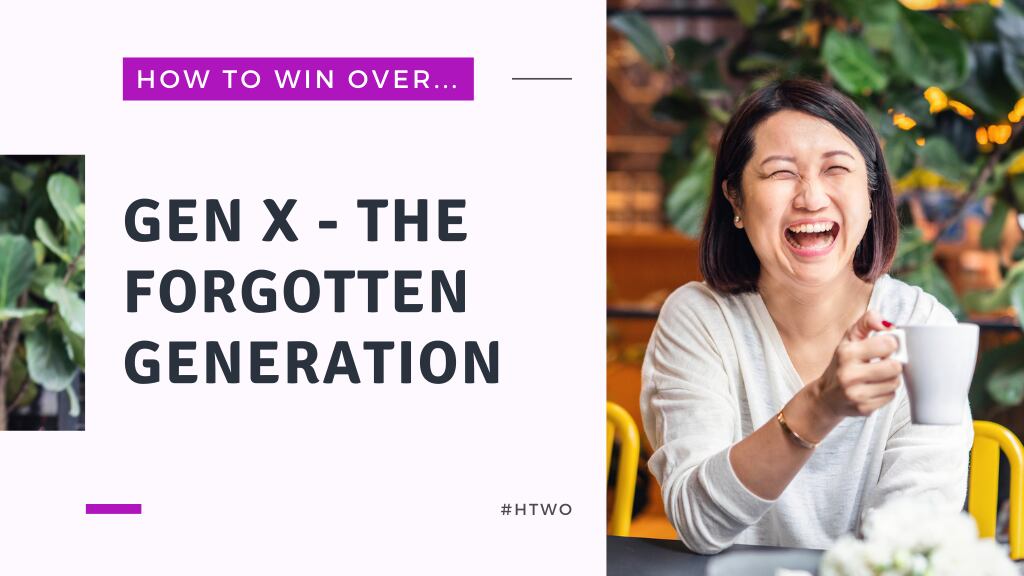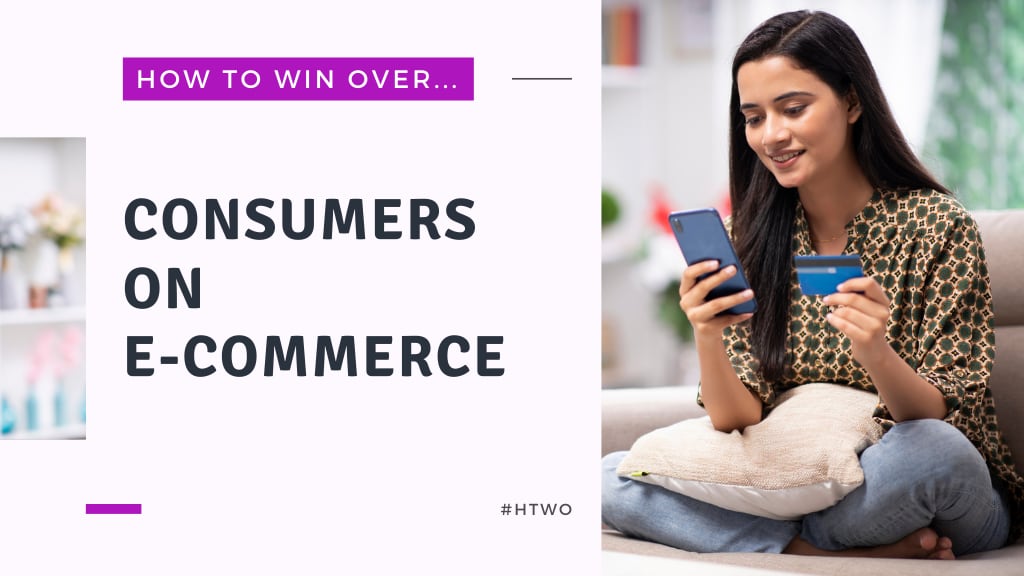Since the 2010s, when Amazon hastened the decline of physical bookstores, pundits have been predicting a retail apocalypse. A landscape littered with shuttered storefronts, where mankind is utterly dependent on Alexa to send orders to a fleet of drones standing ready to deliver anything and everything within hours.
Over a decade later, as we begin emerging from the fight against COVID-19, there are some who believe that our future may very well be headed that way, especially now that the pandemic has undoubtedly accelerated retail’s digital transformation.
In a previous edition of this series, CosmeticsDesign-Asia explored the digital retail landscape and the exciting prospects it would bring with the promise of new channels and new technology.
Research by Alibaba-owned e-commerce platform Lazada reported that 73% of consumers in South East Asia identified online shopping as part of everyday life, with almost half (46%) logging on to shop at least once a week. Nearly 60% said they embraced online shopping as an everyday norm just less than two years ago.
Even beauty, which was once touted as an ‘Amazon-proof’ category, saw a huge shift as consumers warmed up to the idea of buying skin care, make-up, and even perfumes online, all while retail footfall suffered under pandemic-triggered movement restrictions and border closures.
All these trends did not paint a very rosy picture for the brick-and-mortar retail sector. As many established retail players succumbed to the changing times, it seemed that it was the end of traditional brick and mortar retail – the apocalypse was upon us.
Not today, Alexa. As it turns out, the death of brick-and-mortar retail has been greatly exaggerated. It is not declining as much as it is going through a metamorphosis, finding a way to coexist with its digital counterpart, all to make the consumers’ shopping experience that much seamless and pleasurable.
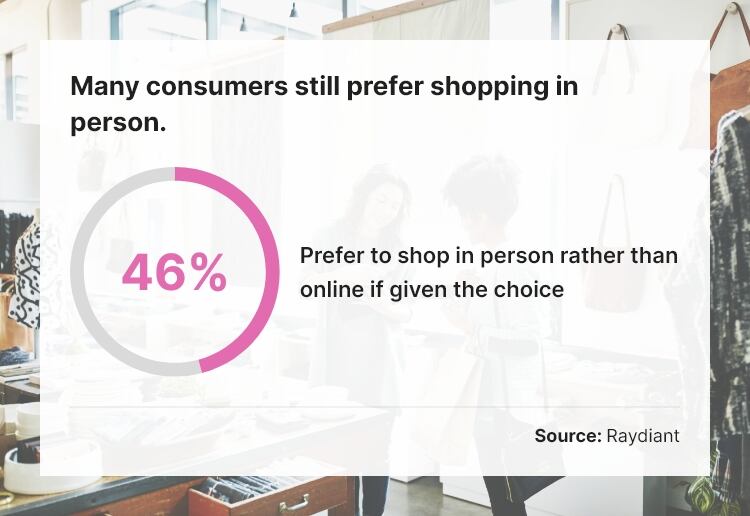
Brick and mortar bounces back: Beauty firms bet big on physical retail
South Korea’s leading health and beauty retailer Olive Young has been enthusiastic about the “clear offline recovery trend” it has observed over the past few months.
Once COVID-19 measures loosened in the country, beauty lovers flocked to its outlets in droves. During this time, the retailer reported that sales at its brick-and-mortar outlets increased by 28% and consumer traffic increased by 20%.
In the downtime of COVID-19, Olive Young had taken the opportunity to refurbish and enhance its stores. The company, owned by the conglomerate, CJ Group, said this had led to a cumulative year-on-year sales increase of 29% at its renewed stores from January to April.
Currently, 250 offline stores are in the process of being renewed and the company also unveiled seven new stores in the first quarter of this year, taking the total number of offline stores to 1,272. Furthermore, it is in the process of a mass hiring spree for several positions in its offline retail business.
Over in India, SUGAR Cosmetics has been similarly optimistic about offline retail recovery.
SUGAR is one of India’s most successful digitally native direct-to-consumer beauty brands. It made its offline debut in 2017, two years after it launched online. Since then, the company has expanded its retail footprint and now has over 35,000 retail touchpoints in over 500 cities.
Despite the challenges that came with the COVID-19 pandemic, the beauty brand forged ahead with its retail expansion plans, launching over 60 stores in March 2020 alone. Recently in May, the company celebrated its 100th exclusive brand store.
Co-founder and CEO Vineeta Singh told us that the company is not done with its offline expansion. “The idea is to open another 100 of our own exclusive brand stores over the next 12 to 18 months and to be a part of another 30,000 of the general and modern trade stores, our partner retailers.”
She continued that the firm had seen a massive recovery in the last three to four months and its numbers have risen “significantly higher than pre-COVID levels”. Today, offline accounts for a majority of its total sales at 60%.
“Going out to shop is still part of the whole experience – it’s entertainment, it’s a family thing to do on the weekends. And make-up is also a very impulse driven category. We’re seeing that behaviour where people continue to go out and shop for make-up impulsively, and just spend time in stores.”
Sephora, the beauty retailer owned by luxury group LVMH, has also observed a marked recovery across its physical stores in the APAC region. Over the past two years, Sephora has opened close to 100 stores in the region, and in the next three years, it has several new store openings planned.
“I think this year we're seeing very, very clear signs,” said Alia Gogi, president of Sephora Asia. “This is a much more considered consumer. They're coming with decisions made in their mind, they're well-informed and they're coming in. In some markets, we are at least at pre-pandemic levels which is great for us. We're very excited to see that.”
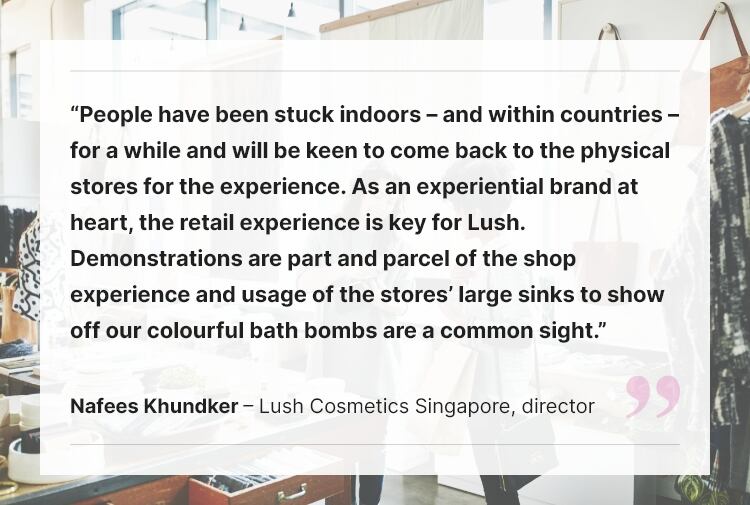
Nafees Khundkher, managing director of Lush Singapore said retail footfall was recovering for the British brand in his market, where most COVID-19 restrictions have lifted.
"Barring a few quiet months, footfall has increased. However, like several other brands, we haven’t seen the full impact of a tourist crowd as compared to pre-COVID yet."
He is expecting to see an increase in physical footfall given the trend of revenge shopping – a result of being cooped up for almost three years.
"People have been stuck indoors – and within countries – for a while and will be keen to come back to the physical stores for the experience. As an experiential brand at heart, the retail experience is key for Lush. Demonstrations are part and parcel of the shop experience and usage of the stores’ large sinks to show off our colourful bath bombs is a common sight."
A whole new role: Offline retail in an online world
It is often said that beauty is a ‘touch and try’ business. Ultimately, the sensorial experience will always beat out clever marketing copy, influencer endorsements, and even advanced augmented reality (AR) applications.
At least for the beauty and personal care industry, physical storefronts will always be needed, but their role and function has evolved in an increasing omnichannel environment. After all, it is no longer a purely transactional arena and does not hold the monopoly as a platform for discovery.
“Consumers are now operating within a total omnichannel ecosystem and all the touchpoints that we've been fortunate to have been developing have helped us as we went into the pandemic, and now it’s helping us as we're coming into the endemic stage,” said Gogi.
“Stores remain a critical part of that transformation journey. And I believe that they will be a critical part of our success. We are developing in every market that we operate, a very clear omnichannel ecosystem, whether that means being present online, being present on social channels, being present in stores, this is all what customers, in my mind, are really looking for.”
The lines between online and offline have blurred over the years and retailers are working toward creating a completely seamless experience for the consumer. CEO of Indian beauty retailer Health & Glow, K Venkataramani, told us that the whole retail experience should emulate video streaming services.
“Let’s use Netflix as an example. I could be watching a series on my phone outside while I have half an hour to kill. Then when I get home, I switch to the big screen, so I don’t strain my eyes. The show is where I left off. There are multiple surfaces, but Netflix is the same. It personalises the recommendations to you equally across all surfaces.
“Whether it is brick and mortar or online, you are the same person to us. When you come into our store, I recognise you as a certain person with all your details. Then when you go online, I will interact with you in the same way, where I left off in the physical store.”
As retailers advance in their goal to create a completely seamless experience and consumers become increasingly ambivalent about which channels they shop at – what then entices them to make the arduous journey to a physical brick and mortar?
“Consumers are not going to go anymore to brick and mortar only for convenience and transaction. They have other ways now to be able to achieve that objective. So, they have an absolute requirement to have an experiential experience in stores, through services, through personalisation, through consultation. These things are critical and must happen in a physical environment,” said Gogi.
Singh envisions that future brick and mortar stores will be less focused on sales and instead emphasise on experience and education and content creation. This means having more ‘Instagram-able’ spots, more events with celebrities or influencers, or beauty services.
“I feel that our own stores will become a lot more about content creation. Consumers can have a makeover in-store, try a lipstick – they might not buy and that’s fine. At the end of the day the idea is that the consumer should buy your product, because she loves the brand, loves the product and she gets to experience it,” said Singh.
“It's not really about making every single footfall convert to a sale. I feel that it's a lot more powerful for the brand in terms of long-term retention and repeats than trying to close the sale over there.”
For SUGAR, investments into brick and mortar also enable the firm to lessen its reliance on performance marketing, an area that many brands are struggling with as customer acquisition costs (CAC) continue to rise.
“Retail has a lot of operating leverage because then you keep growing your numbers without spending additional CAC, which is like paying rent to Google or Facebook to get traffic. In retail, you pay rent to a mall, but the good thing is that the malls don't have algorithms that will keep increasing your rent for additional heavy traffic,” said Singh.
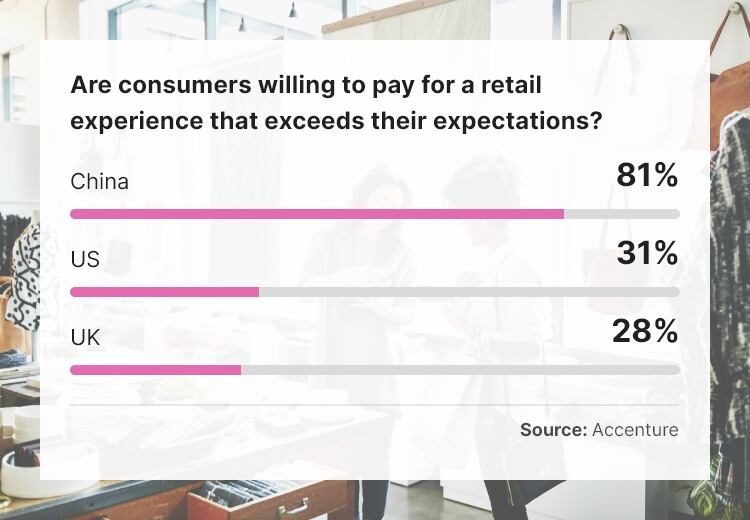
What’s in store: Shaping the future of brick and mortar
The beauty retail space has shifted drastically over the past couple of years, and it is unlikely that it will stop evolving. Elements like personalisation and experiences will continue to play huge roles and the digital aspect of retail will continue to influence brick and mortar retailers moving forward.
“As consumers have adopted to digital experiences a lot more, they're also expecting those types of experiences in our physical stores, whether that happens through consultation with digital tools, whether that happens through payment methods, whether that happens through last-mile options – now consumers want choices, they want to buy anywhere and anytime and through any touchpoint,” said Gogi.
“They want those choices, and so I think you'll find a big shift will start to happen, in particular, from a physical store experience where some of those digital insights that consumers are used to, will be expected in stores.”
Singh agreed: “I think this whole conversation around omnichannel is going to become very dated. It's going to become hygiene for brands to give a uniform experience to the consumer and offline and online. And there will be a lot more technology where, consumers can have endless aisles, home delivery within a few hours. Consumers will use more technology like artificial reality mirrors in the stores which will be easier to experience products and increase time spent in-store.”
These things are already happening with retailers like Sephora, Health & Glow, and Lush Cosmetics.
“With people craving instant gratification, there will be shoppers that appreciate the convenience of online shopping. To that end, we’re now available on Grab and Panda Mart, and we also offer same-day delivery options on our website,” said Khundkher.
“Both traditional retail and online will continue to operate in tangent in the long run, and the brands that will perform well will be the brands that can effectively marry the two together to provide the ultimate customer experience.”
The foreseeable future of retail is not that far away, in fact, it is already reality in China. “In each market, the ecosystem is becoming more and more advanced. Look at China, which I believe is probably the ultimate when it comes to that ecosystem,” said Gogi.
“It’s an absolutely amazing omnichannel ecosystem that China has. It has led the way globally and I see that happening across the rest of Asia. Social commerce continues to have strong traction in the region, live commerce also continuing to have a lot of traction. So, I think in next three to five years, a lot of the China ecosystem will start to be seen across many markets in the rest of Asia.”
And looking further into the future, there is the era of web3 and the metaverse that retailers will have to explore. Retailers like Sephora and SUGAR are already considering the possibilities.
“The metaverse is an incredible innovation that's taking over. Essentially, it's an immersive experience. And I actually think that it will be very complementary to any brand or any retailer that has developed an omnichannel ecosystem, it will be another touchpoint in that ecosystem. So, I don't see it as a competition – I see it very much as a brand immersive experience,” said Gogi.
“Of course we’re thinking about our stores in the metaverse, this is the biggest trend that will impact everything related to retail,” said Singh. “Like with every shift, what happens is there’s a lot of talk but not much action. But then you know for sure in the next five years you will start seeing exponential growth, so you have to be ready for sure.”
We can only speculate how the emergence of web3 will change the retail space, but for now, it only shows that traditional storefronts are far from dead. In fact, they are alive and kicking with exciting prospects. Brick and mortar retailers can indeed flourish in an increasingly digital world, as long as they embrace digital advancements and provide consumers with experiences worth leaving home for.



